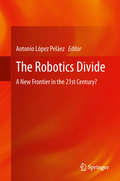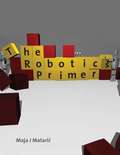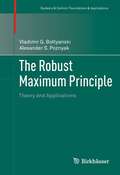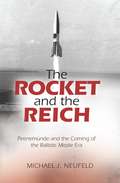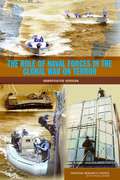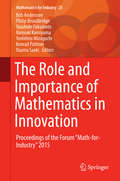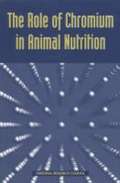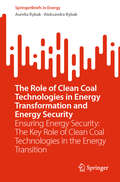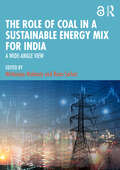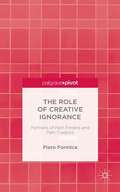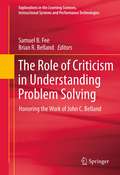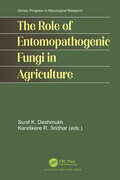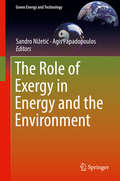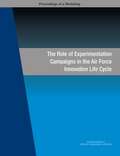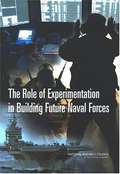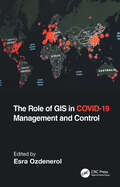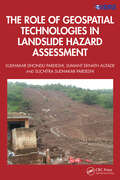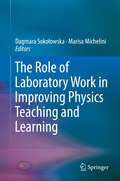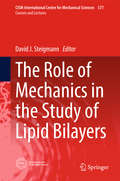- Table View
- List View
The Robotics Divide: A New Frontier in the 21st Century?
by Antonio López PeláezSocieties survive in their environment and compete with each other depending on the technology they develop. Economic, military and political power are directly related to the available technology, while access to technology is key to the well-being of our societies at the individual, community and national level. The Robotics Divide analyzes how robotics will shape our societies in the twenty-first century; a time when industrial and service robotics, particularly for military and aerospace purposes, will become an essential technology. The book, written by experts in the field, focuses on the main technological trends in the field of robotics, and the impact that robotics will have on different facets of social life. By doing so, the authors aim to open the "black box" of a technology which, like any other, is designed, implemented and evaluated according to the economic and cultural patterns of a cosmopolitan society, as well as its relations of power. The Robotics Divide explores future developments in robotics technology and discusses the model of technological development and the implementation of robotics in this competitive market economy. Then the authors examine to what extent it is possible to determine the characteristic features of the robotic divide, namely in what ways the robotic divide differs from the digital divide, and how a model to integrate this technology can be developed without reproducing patterns of inequality and power that have characterized the advent of previous technologies. These issues - inequality, robotics and power - are of concern to robotics and advanced automation engineers, social scientists, economists and science policy experts alike.
The Robotics Primer
by Maja J. MatarićChoice Outstanding Academic Title, 2008. The Robotics Primer offers a broadly accessible introduction to robotics for students at pre-university and university levels, robot hobbyists, and anyone interested in this burgeoning field. The text takes the reader from the most basic concepts (including perception and movement) to the most novel and sophisticated applications and topics (humanoids, shape-shifting robots, space robotics), with an emphasis on what it takes to create autonomous intelligent robot behavior. The core concepts of robotics are carried through from fundamental definitions to more complex explanations, all presented in an engaging, conversational style that will appeal to readers of different backgrounds. The Robotics Primer covers such topics as the definition of robotics, the history of robotics ("Where do Robots Come From?"), robot components, locomotion, manipulation, sensors, control, control architectures, representation, behavior ("Making Your Robot Behave"), navigation, group robotics, learning, and the future of robotics (and its ethical implications). To encourage further engagement, experimentation, and course and lesson design, The Robotics Primer is accompanied by a free robot programming exercise workbook. The Robotics Primer is unique as a principled, pedagogical treatment of the topic that is accessible to a broad audience; the only prerequisites are curiosity and attention. It can be used effectively in an educational setting or more informally for self-instruction. The Robotics Primer is a springboard for readers of all backgrounds--including students taking robotics as an elective outside the major, graduate students preparing to specialize in robotics, and K-12 teachers who bring robotics into their classrooms.
The Robots are Here
by Rosemary Sage Riccarda MatteucciTechnology is redefining what it means to live in society and be human.This book assembles research and practice on educational robotics (intelligent machines) with a particular focus on the practices in Britain and Italy, the latter of which is a leading nation in preparing students for the New Industrial Age.Now that intelligent machines are capable of undertaking all routing tasks, robotics can provide three-dimensional development - personal, practical and academic - for the improved communication and thinking that students need for higher-level work. Students no longer need drilling in facts, now accessed by the touch of a button, but require greater attention to personal and practical abilities to meet global challenges.Readers are made aware of new learning approaches to achieve the flexible, broader abilities that aid survival and well-being.
The Robust Maximum Principle: Foundations And Applications: Robust Maximum Principle: Theory And Applications (Systems And Control: Foundations And Applications Ser.)
by Vladimir G. Boltyanski Alexander S. PoznyakCovering some of the key areas of optimal control theory (OCT), a rapidly expanding field, the authors use new methods to set out a version of OCT's more refined 'maximum principle.' The results obtained have applications in production planning, reinsurance-dividend management, multi-model sliding mode control, and multi-model differential games. This book explores material that will be of great interest to post-graduate students, researchers, and practitioners in applied mathematics and engineering, particularly in the area of systems and control.
The Rocket Man
by David DarlingThe wonder of flight has long captured the human imagination. In this beguiling history - ranging from the first aircraft to astronauts and beyond - David Darling tells the stories of the true life adventurers whose wonder has translated into bizarre contraptions, magnificent achievements and, sometimes, startling folly. Discover outrageous attempts to fly like a bird and the secret military planes that never made it off the ground - including the flying pancake and the plane with thirty wings. Meet Napoleonic ballooniste Sophie Blanchard who planned an aerial invasion of England, stuntman Lincoln Beachey, looping-the-loop in a pinstripe suit and, of course, The Rocket Man himself: Yves Rossy, who in 2006 was the first person to fly with the aid of a jet-pack. Eccentric and imaginative, reckless and resourceful - Darling's daring cast of dreamers is guaranteed to entertain and inspire.
The Rocket and the Reich: Peenemunde and the Coming of the Ballistic Missile Era
by Michael J. NeufeldWINNER OF THE DEXTER PRIZE OF THE SOCIETY FOR THE HISTORY OF TECHNOLOGY Launched by the Third Reich in late 1944, the first ballistic missile, the V-2, fell on London, Paris, and Antwerp after covering nearly two hundred miles in five minutes. It was a stunning achievement, one that heralded a new age of ballistic missiles and space launch vehicles. Michael J. Neufeld gives the first comprehensive and accurate account of the story behind one of the greatest engineering feats of World War II. At a time when rockets were minor battlefield weapons, Germany ushered in a new form of warfare that would bequeath a long legacy of terror to the Cold War, as well as the means to go into space. Both the US and USSR's rocket programs had their origins in the Nazi state.
The Role Of Naval Forces In The Global War On Terror
by National Research Council of the National AcademiesThe growth of the terrorism threat to the nation’s security has created significant strategic challenges for U.S. armed forces in fighting this global war on terrorism (GWOT). For the Navy, the challenges have centered on developing maritime capabilities to prosecute the GWOT as far forward as possible. To assist the Navy’s planning in this area, the former Chief of Naval Operations requested the NRC to conduct an assessment of the adequacy of and prospects for improving the role of Naval Forces in the GWOT. The study developed a defense-in-depth framework as the organizing principle for the report. The report contains information as described in 5 U.S.C. 552(b) and therefore could not be released to the public in its entirety. The public version consists of an executive summary that presents an assessment of the transformation of naval forces for addressing the GWOT; a brief description of the defense-in-depth framework; and a list of findings and major recommendations.
The Role and Importance of Mathematics in Innovation
by Bob Anderssen Philip Broadbridge Yasuhide Fukumoto Naoyuki Kamiyama Yoshihiro Mizoguchi Konrad Polthier Osamu SaekiThis book is a collection of papers presented at the "Forum Math-for-Industry 2015" for which the unifying theme was "The Role and Importance of Mathematics in Innovation", held at the Institute of Mathematics for Industry, Kyushu University, October 26-30, 2015. The theme highlights two key roles that mathematics plays in supporting innovation in science, technology, and daily life, namely, needs-based and idea-based. For the former, mathematics assists with sorting through the possibilities and putting matters on a more rigorous foundation, and for the latter, mathematical models of the possible implementations play a key role. The book gives excellent examples of how mathematics assists with stimulating innovation and, thereby, highlights the importance and relevance of the concept Mathematics_FOR_Industry. The contents of this volume address productive and successful interaction between industry and mathematicians, as well as the cross-fertilization and collaboration that result when mathematics is involved with the advancement of science and technology.
The Role of Agriculture in Climate Change Mitigation
by Lucjan PawłowskiAccording to IPCC reports, one of the greatest threats to the Earth ecosystems is climate change caused by the anthropogenic emissions of greenhouse gases, mostly carbon dioxide, mainly from the combustion of fossil fuels, cement production and land-use change which leads to an excessive temperature rise. Agriculture and forestry are responsible for quiet big emissions of greenhouse gases: CO2, CH4 and N2O, and have significant potential to reduce these emissions mainly through enhancement of CO2 absorption by terrestrial ecosystems. To evaluate the impact of agriculture on climate change, ruminant farming should be also taken into account. These animals emit considerable amounts of methane which has strong greenhouse effects. Methane emissions may be reduced by using appropriate feed for ruminants. Decreasing the meat consumption of these animals can also make an important contribution to reducing methane emissions. The methods for reducing greenhouse gas emissions through appropriate management of terrestrial ecosystems and animal husbandry are widely discussed in The Role of Agriculture in Climate Change Mitigation. The book will be of interest to academics, professionals and policy makers in environmental sciences.
The Role of Chromium in Animal Nutrition
by Committee on Animal NutritionThe American feed industry manufactures tons of dietary supplements and additives each year for inclusion in the diets of food-producing animals. Some scientists have suggested that chromium should be a key ingredient in nutritional supplements. Controversy exists, however, over whether chromium sources should be approved as feed additives and whether enough data exist to establish dietary requirements. Chromium use has been suggested to have positive impacts on farm profitability, and many animal health benefits have been attributed to chromium supplementation, including increased longevity; enhanced reproduction; decreased incidence of metabolic disorders, stress effects, and disease; reduced need for antibiotic usage; improved immune response; and lean carcass quality.This book addresses recent research on chromium in animal diets; metabolic interactions between chromium and other nutrients; assessments of form and species interactions; supplementation effects; bioavailability of chromium forms and sources; and effects of diet composition, stressors, and animal physiological status on chromium utilization. It also provides recommendations on the essentiality of dietary chromium in domestic animal species and guidelines for use of dietary chromium.
The Role of Clean Coal Technologies in Energy Transformation and Energy Security: Ensuring Energy Security: The Key Role of Clean Coal Technologies in the Energy Transition (SpringerBriefs in Energy)
by Aurelia Rybak Aleksandra RybakThis book presents the latest achievements in the field of clean coal technologies and shows how these innovations contribute to environmental protection and ensure stability of energy supplies. The book describes how clean coal technologies can revolutionize our energy future. From advanced mining methods to modern energy storage solutions, this book is a source of knowledge about sustainable development and technological innovation.
The Role of Coal in a Sustainable Energy Mix for India: A Wide-Angle View
by Mritiunjoy Mohanty and Runa SarkarAs India switches away from a coal-based to a more sustainable energy use pattern, which pathway will it adopt? What is the nature of challenges that it will face, and who will be affected? Who will gain? This volume offers insights into the steps and challenges involved in this transition and addresses some urgent questions about the possible pathways for India’s renewable energy generation. Including contributions from researchers, policymakers, and practitioners, it draws on different disciplines, ranging from science and technology to economics and sociology, and situates the issue of low carbon transition within an interdisciplinary framework. India has committed to gradual decarbonisation of its economy. This book takes this as its starting point and uses a wide-angle lens, incorporating macro as well as micro views, to understand the possible next steps as well as trade-offs that will inevitably be posed. It incorporates the perspectives of all stakeholders ranging from central and state governments, public and private sector firms, on the one hand, to individuals and local communities, on the other, to explore their role in the transition, their interests, and how these will change and evolve. This timely volume will be of interest to students and researchers of environmental studies, development studies, environmental economics, political studies, and Asian studies. It will also be useful to academics, practitioners, and policymakers working on issues related to climate change, sustainable development, energy policy and economics,and public policy.
The Role of Creative Ignorance: Portraits of Path Finders and Path Creators
by Piero FormicaThe Role of Creative Ignorance outlines the importance of creative ignorance using narrative examples of innovators and companies worldwide.
The Role of Criticism in Understanding Problem Solving
by Samuel Fee Brian BellandIn 1991, Denis Hlynka and John Belland released Paradigms Regained, a well received reader for graduate students in the field of educational technology. The Role of Criticism in Understanding Problem Solving updates some of those ideas initially proposed in Paradigms Regained, and extends the conversation into the contemporary discourse regarding problem based learning (PBL). Paradigms proposed the idea of criticism as a third method for the conduction of educational research, the first two being qualitative and qualitative. The concept of criticism as a tool for research is not well established in educational technology, although it is well established in other educational research traditions such as Curriculum Studies. Unfortunately, it is not always clear how criticism can be applied. This book views criticism as a way to step back and look at an educational intervention within educational technology through a particular critical lens. Criticism is viewed as a valuable approach to guiding meta analyses and theoretical studies, serving to prevent the proverbial "spinning of the wheels" that often happens in educational research. By indicating new potential research questions and directions, criticism approaches can invigorate educational research. This book revisits the ideals of criticism in order to establish their usefulness for studying educational technology interventions to support problem based learning. First, a few foundational chapters set the stage for the conversations on criticism. Then, the role criticism can play in enhancing analysis and interpretation of the PBL literature is explored. Finally, case studies addressing the central concepts of the text are presented and dissected. This book represents a complete overhaul and rethinking of the use of criticism as a method for understanding and furthering the research area of PBL within the field of Educational technology.
The Role of Entomopathogenic Fungi in Agriculture (Progress in Mycological Research)
by Sunil K. Deshmukh Kandikere R. SridharEntomopathogenic fungi are economically important fungi from environmental, agricultural, and human health perspectives. They are an alternative to chemical pesticides. They can also be used as biostimulants and biological control agents for mosquitoes and other insects. These fungi are also known to produce a variety of metabolites of industrial significance. They face challenges in the cultivation, fermentation, and purification of products. Their habitats and ecological niches are of special significance for ex situ conservation and the large scale of production of spores.This book reviews molecular aspects of the pathogenesis of entomopathogenic fungi, the development of mycoinsecticides, and its regulatory aspects. It addresses different aspects of entomopathogenic fungi, including host-pathogen interactions (susceptibility and resistance), fungus-insect and fungus-fungus dual interactions, phylogeny and taxonomy, biochemistry, and molecular basis of enteropathogenesis, market potential of entomopathogens, regulatory aspects, bioprospecting of fungi, fungi as crop bodyguards and in disease suppression, and consortia for the control of insect pests and pathogens in single crop systems.
The Role of Exergy in Energy and the Environment (Green Energy and Technology)
by Sandro Nižetić Agis PapadopoulosThis book is devoted to the analysis and applications of energy, exergy, and environmental issues in all sectors of the economy, including industrial processes, transportation, buildings, and services. Energy sources and technologies considered are hydrocarbons, wind and solar energy, fuel cells, as well as thermal and electrical storage. This book provides theoretical insights, along with state-of-the-art case studies and examples and will appeal to the academic community, but also to energy and environmental professionals and decision makers.
The Role of Experimentation Campaigns in the Air Force Innovation Life Cycle
by Engineering Medicine National Academies of SciencesThe Air Force (USAF) has continuously sought to improve the speed with which it develops new capabilities to accomplish its various missions in air, space, and cyberspace. Historically, innovation has been a key part of USAF strategy, and operating within an adversary’s OODA loop (observe, orient, decide, act) is part of Air Force DNA. This includes the ability to deploy technological innovations faster than do our adversaries. The Air Force faces adversaries with the potential to operate within the USAF’s OODA loop, and some of these adversaries are already deploying innovations faster than the USAF. The Role of Experimentation Campaigns in the Air Force Innovation Life Cycle examines the current state of innovation and experimentation in the Air Force and best practices in innovation and experimentation in industry and other government agencies. This report also explores organizational changes needed to eliminate the barriers that deter innovation and experimentation and makes recommendations for the successful implementation of robust innovation and experimentation by the Air Force.
The Role of Experimentation Campaigns in the Air Force Innovation Life Cycle: Proceedings of a Workshop
by Engineering Medicine National Academies of SciencesThe Workshop on the Role of Experimentation Campaigns in the Innovation Cycle was held in January 2016 to define and assess the current use of experimentation campaigns within the Air Force, evaluate barriers to their use, and make recommendations to increase their use. Participants at the workshop presented a broad range of issues, experiences, and insights related to experimentation, experimentation campaigns, and innovation. This publication summarizes the presentations and discussions from the workshop.
The Role of Experimentation in Building Future Naval Forces
by Committee for the Role of Experimentation in Building Future Naval ForcesThe Department of Defense is in the process of transforming the nation’s armed forces to meet the military challenges of the 21st century. Currently, the opportunity exists to carry out experiments at individual and joint service levels to facilitate this transformation. Experimentation, which involves a spectrum of activities including analyses, war games, modeling and simulation, small focused experiments, and large field events among other things, provides the means to enhance naval and joint force development. To assist the Navy in this effort, the Chief of Naval Operations (CNO) asked the National Research Council (NRC) to conduct a study to examine the role of experimentation in building future naval forces to operate in the joint environment. The NRC formed the Committee for the Role of Experimentation in Building Future Naval Forces to perform the study.
The Role of Fuels in Transforming Energy End-Use in Buildings and Industrial Processes (Synthesis Lectures on Engineering, Science, and Technology)
by Praveen Cheekatamarla Kyle Gluesenkamp Stephen Kowalski Zhenning Li Saad JajjaEnergy-efficient technologies are necessary to lower the carbon footprint for a transition towards clean energy in a sustainable manner. This book examines what role fuels have in the transformation of end-use in buildings and industrial processes. Energy-efficient technologies are necessary to lower the carbon footprint for a transition towards clean energy in a sustainable manner. Efficient utilization of primary energy resources, including renewables, to support the current and future energy needs while targeting grid resiliency, energy, and environmental security at an affordable cost is of significant value. The author analyzes heat pumps, fuel-driven thermal providers, and power systems configurations and looks at the sensitivity of the electrical grid's carbon intensity and tariff towards carbon footprint and energy costs compared with fuel-driven technologies. The role of low-carbon, zero-carbon, and carbon-negative fuels, such as power-to-gas (P2G), power-to-liquid (PtL), hydrogen, and biogas, in conjunction with polygeneration technologies, are discussed. This book also examines two different scenarios focused on the sensitivity of the pace of decarbonization of the electrical grid and fuel supply on operational energy-related carbon emissions.Compares electricity versus fuel as a primary energy sourceExplores the role of fuels in the decarbonization journey Examines the value proposition of currently available energy solutions
The Role of GIS in COVID-19 Management and Control
by Esra OzdenerolGeographic Information System (GIS) is one of the most important tools to help us understand public health and many aspects of our lives. Because of COVID-19, GIS has been brought into the spotlight more than ever before. People and civic leaders worldwide are turning to maps and real-time surveillance data to make sense of what has been happening in the world and to get answers to important questions on every aspect of this pandemic. This book examines the role of GIS in managing and controlling the spread of COVID-19 through 12 global projects and a multidisciplinary approach. It explains the innovative uses of GIS not only limited to data organization and data access, but also how improved GIS tools are used to make decisions, plan, and communicate various measures of control in both local and full-scale outbreaks during the COVID-19 pandemic. Features: Provides cutting-edge GIS visualization, spatial temporal pattern, and hot spot tracking applications used for predictive modeling of COVID-19. Includes real-world case studies with broad geographic scope that reflect COVID-19 trends in cases, deaths, and vaccinations. Provides lifestyle segmentation analysis on the risk of transmission of COVID-19 and spatial patterns of vaccination hesitancy. Highlights real-world issues brought to light with the help of GIS, such as social discrimination, inequalities in women’s access to mental health care, and analyzes the risk of transmission due to vaccination hesitancy. Shows the use of GIS and spatial analysis in pandemic mapping, management, and control from masking and social distancing to testing site locations accounting for at-risk and vulnerable populations. Discusses facilitating policy making with GIS. Edited by a very talented medical geographer and GIS Professor Dr. Esra Ozdenerol, this book highlights key GIS capabilities and lessons learned during the COVID-19 response that can help communities prepare for the next crisis. It is a great resource for industry professionals and experts in health care, public health and safety, disaster management, and for students, academics, and researchers interested in applying GIS and spatial analysis to the study of COVID-19 and other pandemics.
The Role of Geospatial Technologies in Landslide Hazard Assessment
by Sudhakar Dhondu Pardeshi Sumant Eknath Autade Suchitra Sudhakar PardeshiThis book is designed to provide a detailed, methodological framework for landslide hazard assessment. The focus is on various dimensions of landslide hazard assessment, including the terminologies used in landslide hazard analysis and landslide inventory systems used globally and their relevance in generating a complete and reliable landslide database for further analysis, supported by global case studies. It includes an overview of the methodological developments in landslide hazard assessment and role of geospatial technologies in landslide studies.Features: Helps readers to understand the technical details of geospatial techniques applied in hazard management. Deals with the practicalities of how to recognise and classify unstable terrain. Covers recent advances in landslide estimation, particularly the automated means of landslide susceptibility estimation. Explores methodological frameworks of landslide hazard assessment. Illustrates case studies from the United States, Europe, and Asia, including demonstrations of different methodologies of landslide susceptibility zonation. This book is aimed at researchers, graduate students, and libraries in geotechnical and environmental engineering.
The Role of Inter- and Intraindustry Trade in Technology Diffusion
by Dalia Hakura Florence JaumotteA report from the International Monetary Fund.
The Role of Laboratory Work in Improving Physics Teaching and Learning
by Marisa Michelini Dagmara SokołowskaThis book explores in detail the role of laboratory work in physics teaching and learning. Compelling recent research work is presented on the value of experimentation in the learning process, with description of important research-based proposals on how to achieve improvements in both teaching and learning. The book comprises a rigorously chosen selection of papers from a conference organized by the International Research Group on Physics Teaching (GIREP), an organization that promotes enhancement of the quality of physics teaching and learning at all educational levels and in all contexts. The topics covered are wide ranging. Examples include the roles of open inquiry experiments and advanced lab experiments, the value of computer modeling in physics teaching, the use of web-based interactive video activities and smartphones in the lab, the effectiveness of low-cost experiments, and assessment for learning through experimentation. The presented research-based proposals will be of interest to all who seek to improve physics teaching and learning.
The Role of Mechanics in the Study of Lipid Bilayers (CISM International Centre for Mechanical Sciences #577)
by David J. SteigmannThis book is the first collection of lipid-membrane research conducted by leading mechanicians and experts in continuum mechanics. It brings the overall intellectual framework afforded by modern continuum mechanics to bear on a host of challenging problems in lipid membrane physics. These include unique and authoritative treatments of differential geometry, shape elasticity, surface flow and diffusion, interleaf membrane friction, phase transitions, electroelasticity and flexoelectricity, and computational modelling.
